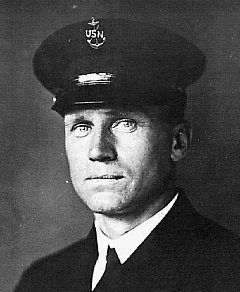

Citation: For distinguishing himself conspicuously by courage and intrepidity at the risk of his life as a member of the Byrd Arctic Expedition and thus contributing largely to the success of the first heavier-than-air flight to the North Pole and return.
In 1917, he enlisted in the United States Navy and signed up for aviation training, but although he became a capable pilot he was retained for service as an aviation mechanic.
His chance for fame came in 1925 when he was assigned to duty with Lieutenant Commander Richard E. Byrd’s naval aviation group attached to D. B. MacMillan’s expedition to Greenland in that year. Both his character and ability caught the attention of his commander, and he soon became Byrd’s close friend and personal pilot.
Together they planned a flight over the North Pole, and on a second expedition in the next year they carried out the plan, flying a 3-engine Fokker monoplane, the Josephine Ford, from Spitsbergen to the pole and back on May 9.
Both men were awarded the Medal of Honor for their feat, one of the rare peacetime awards of the Medal. Byrd was promoted to Commander and Bennett, by Act of Congress, to Warrant Mechanic.
He and Byrd then began planning for an air crossing of the Atlantic in their second plane, the America, but Bennett suffered serious injuries when the America crashed, opening the way for Charles Lindbergh to make the first trans-Atlantic flight.
Bennett was appointed second-in-command of Byrd’s 1928–30 expedition to the South Pole, most of the details he had planned. Before the expedition set out, he and Bernt Balchen set out to salvage the Bremen, the first aircraft to cross the Atlantic westwards, which had gone down off the coast of Labrador.
On the way Bennett fell ill and died at Quebec, Canada, on 25 April 1928. He was mourned throughout the United States as a national hero, and Byrd christened his plane for that expedition the Floyd Bennett. He had also been awarded a special medal of the National Geographic Society, with its seal on the reverse side, presented by President Calvin Coolidge in 1926. He was buried in Section 3 of Arlington National Cemetery.
New York City’s first municipal airport, Floyd Bennett Field in Brooklyn (later Naval Air Station New York), and Floyd Bennett Memorial Airport in Glens Falls, New York, were named for him.
Source: Arlington National Cemetery.